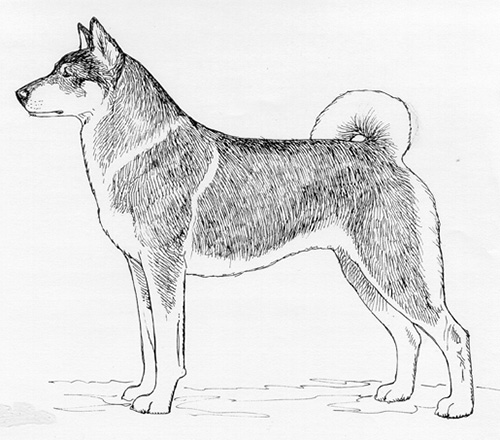West Siberian Laika
Northern Breed Group
The goals and purposes of this breed standard include: to furnish guidelines for breeders who wish to maintain the quality of their breed and to improve it; to advance this breed to a state of similarity throughout the world; and to act as a guide for judges.
Breeders and judges have the responsibility to avoid any conditions or exaggerations that are detrimental to the health, welfare, essence and soundness of this breed, and must take the responsibility to see that these are not perpetuated.
Any departure from the following should be considered a fault, and the seriousness with which the fault should be regarded should be in exact proportion to its degree and its effect upon the health and welfare of the dog and on the dog’s ability to perform its traditional work.
History
The West Siberian Laika originally comes from the North Ural and West Siberia. The current breed was developed from two different types. The breed is lighter in build and narrower in head than the East Siberian Laika. It is an all around hunting dog, used on birds and small game and also occasionally on large game.
The West Siberian Laika was recognized by the United Kennel Club on January 1, 1996.
General Appearance
A medium sized, strong, well built northern breed, with a general wolf-like appearance. The breed is never coarse or massive. Due to the arctic conditions in the country of origin, the coat is very important. It must be double, dense, very hard and not too long.
Characteristics
Intelligent, willing to learn and easily trainable. Affectionate and loyal to his family, and friendly to strangers. The breed has a strongly developed hunting instinct and a keen sense of direction. When he finds game, he alerts the hunter by barking.
Head
SKULL
Shaped like an equilateral triangle. Gradual, barely noticeable stop.
MUZZLE
Long and dry.
TEETH
The West Siberian Laika has a complete set of evenly spaced, white teeth meeting in a scissors bite.
NOSE
Black.
EYES
Oval, slanting and dark in color.
EARS
Prick, set on high and pointed.
Neck
Muscular and dry.
Forequarters
Well defined angulation between shoulder blade and upper arm.
FORELEGS
Legs are long and muscular with short, flexible pasterns.
Body
The chest is well developed, and the withers are very pronounced. The back is strong and straight, and the loin is short and supple. The croup is broad, muscular and slightly sloping. There is a slight tuck-up.
Hindquarters
Muscular and strong, with good angulation.
Feet
Oval, with tight, arched toes.
Tail
Strongly curled and carried over the back or buttocks.
Coat
Double, with a hard, straight outer coat and a well developed undercoat. Due to the abundance of undercoat, the outer coat stands off the body slightly. On the head, ears and front of the legs, the hair is short. On the withers, neck, shoulders and back of the legs, it is longer. It forms a beard on the cheekbones, a collar on the neck, and slight breeches on the back of the thighs.
Color
White, salt and pepper, red, and grey of all shades. Solid black is permitted, as are white dogs with patches of salt and pepper, red or grey.
Height
Height at the withers for males is 21 to 23.5 inches. For females, it is 20.5 to 23 inches.
Gait
Typical movement is a short trot.
Disqualifications
(A dog with a Disqualification must not be considered for placement in a conformation event, and must be reported to UKC.)
Unilateral or bilateral cryptorchid.
Viciousness or extreme shyness.
Albinism.

Looking for a Dog?
Find a dog that will fit your family.
Note: The breeders on this list are not endorsed by UKC.
©Copyright 1996, United Kennel Club
